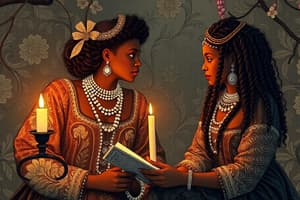Podcast
Questions and Answers
What factors contributed to the high value placed on young enslaved men?
What factors contributed to the high value placed on young enslaved men?
- Their ability to reproduce, contributing to the growth of the enslaved population.
- Their potential for skilled work and their strength. (correct)
- Their ability to perform labor more effectively than older enslaved men.
- Their relative youth and the expectation of loyalty and obedience. (correct)
What was the significance of the onset of menstruation for enslaved women?
What was the significance of the onset of menstruation for enslaved women?
- It increased their physical strength and capacity for labor.
- It marked the transition from childhood to womanhood. (correct)
- It made them more appealing to potential buyers in slave auctions.
- It made them highly valued for their reproductive capacity. (correct)
What is the main point of the text regarding Joseph's experience on the auction block?
What is the main point of the text regarding Joseph's experience on the auction block?
- Joseph's experience on the auction block was similar to that of other enslaved children.
- Joseph's reaction to being sold is unknown, but the text raises questions about his state of mind. (correct)
- Joseph's adolescence prepared him for the trauma of being sold.
- Joseph was comforted by the auctioneer's complimentary descriptions.
What role did the auctioneer play in emphasizing the value of enslaved individuals?
What role did the auctioneer play in emphasizing the value of enslaved individuals?
What did enslaved children hold onto as they stepped onto the auction block?
What did enslaved children hold onto as they stepped onto the auction block?
Why was Joseph considered a "capital" boy in the slave auction?
Why was Joseph considered a "capital" boy in the slave auction?
Which of the following best describes the value placed on young bodies during the period described in the text?
Which of the following best describes the value placed on young bodies during the period described in the text?
What does the text suggest about the value of enslaved people's spiritual and psychological lives?
What does the text suggest about the value of enslaved people's spiritual and psychological lives?
How did enslaved people develop their spiritual values, according to the text?
How did enslaved people develop their spiritual values, according to the text?
Which of the following best describes the economic value of enslaved women during the period described in the text?
Which of the following best describes the economic value of enslaved women during the period described in the text?
What is the significance of the observation that Joseph and Isam approached the auction block in silent prayer?
What is the significance of the observation that Joseph and Isam approached the auction block in silent prayer?
How did the auctioneer's description of Joseph's skills illustrate the economic value placed on enslaved people in the context of slavery?
How did the auctioneer's description of Joseph's skills illustrate the economic value placed on enslaved people in the context of slavery?
What does the story Lucy Delaney share about the slave auction illustrate about the practice?
What does the story Lucy Delaney share about the slave auction illustrate about the practice?
What made the pubescent years terrifying for enslaved children?
What made the pubescent years terrifying for enslaved children?
Which of the following is NOT mentioned in the text as a way enslaved people expressed their inner spirit?
Which of the following is NOT mentioned in the text as a way enslaved people expressed their inner spirit?
What is the primary argument the text makes concerning the impact of slavery?
What is the primary argument the text makes concerning the impact of slavery?
Which of the following is NOT a consequence of slavery discussed in the text?
Which of the following is NOT a consequence of slavery discussed in the text?
What is the central theme of the text concerning the importance of storytelling?
What is the central theme of the text concerning the importance of storytelling?
What does the text suggest we should learn from the legacy of slavery?
What does the text suggest we should learn from the legacy of slavery?
Which of the following best describes the overall tone of the text?
Which of the following best describes the overall tone of the text?
What was the main reason enslaved children were separated from their families?
What was the main reason enslaved children were separated from their families?
What aspect of enslaved individuals' lives did their enslavers try to commodify, according to the text?
What aspect of enslaved individuals' lives did their enslavers try to commodify, according to the text?
What did enslaved people discover during puberty and adulthood that helped them cope with enslavement?
What did enslaved people discover during puberty and adulthood that helped them cope with enslavement?
How did the onset of menstruation for girls impact the way they were viewed by their enslavers?
How did the onset of menstruation for girls impact the way they were viewed by their enslavers?
What was the purpose of the text's focus on enslaved children's experiences?
What was the purpose of the text's focus on enslaved children's experiences?
Why were enslaved men also valuable for their bodies and their potential as breeders?
Why were enslaved men also valuable for their bodies and their potential as breeders?
What is the main idea the text conveys about the impact of the onset of puberty on enslaved individuals?
What is the main idea the text conveys about the impact of the onset of puberty on enslaved individuals?
How did the text portray the experience of separation from families for enslaved children?
How did the text portray the experience of separation from families for enslaved children?
What did enslaved people often turn to during their time in slavery?
What did enslaved people often turn to during their time in slavery?
What did enslaved people do to resist their enslavement?
What did enslaved people do to resist their enslavement?
How did the enslavers treat the enslaved?
How did the enslavers treat the enslaved?
What aspect of enslaved people did enslavers value most?
What aspect of enslaved people did enslavers value most?
Why did enslaved people find value in their souls?
Why did enslaved people find value in their souls?
How did enslaved people escape the brutality of slavery?
How did enslaved people escape the brutality of slavery?
What is the significance of the "invisible institution" mentioned in the text?
What is the significance of the "invisible institution" mentioned in the text?
What was the main purpose of the "invisible institution"?
What was the main purpose of the "invisible institution"?
Flashcards
Average Appraised Values
Average Appraised Values
The estimated worth of enslaved individuals, measured by gender.
Average Sale Prices
Average Sale Prices
The typical monetary amount received for enslaved individuals during sales.
Joseph's Auction
Joseph's Auction
A story illustrating the excitement surrounding a young enslaved male at auction due to his potential.
Lucy's Slavery Account
Lucy's Slavery Account
Signup and view all the flashcards
Value of Young Bodies
Value of Young Bodies
Signup and view all the flashcards
Transition to Adulthood
Transition to Adulthood
Signup and view all the flashcards
Women's Value in Slavery
Women's Value in Slavery
Signup and view all the flashcards
Economic Value of Youth
Economic Value of Youth
Signup and view all the flashcards
Joseph's experience of being sold
Joseph's experience of being sold
Signup and view all the flashcards
The auction block description
The auction block description
Signup and view all the flashcards
Trauma of being sold
Trauma of being sold
Signup and view all the flashcards
Silent prayer on the auction block
Silent prayer on the auction block
Signup and view all the flashcards
Soul values
Soul values
Signup and view all the flashcards
Inner spiritual centering
Inner spiritual centering
Signup and view all the flashcards
Impact of puberty on enslaved children
Impact of puberty on enslaved children
Signup and view all the flashcards
Joseph and Isam's preaching abilities
Joseph and Isam's preaching abilities
Signup and view all the flashcards
Invisible Institution
Invisible Institution
Signup and view all the flashcards
Resistance Against Abuse
Resistance Against Abuse
Signup and view all the flashcards
Faith as Survival
Faith as Survival
Signup and view all the flashcards
Escape to Freedom
Escape to Freedom
Signup and view all the flashcards
Economic Valuation of Enslaved People
Economic Valuation of Enslaved People
Signup and view all the flashcards
Death and Slavery
Death and Slavery
Signup and view all the flashcards
Profit-seeking Exploitation
Profit-seeking Exploitation
Signup and view all the flashcards
Commodification of Enslaved Bodies
Commodification of Enslaved Bodies
Signup and view all the flashcards
Impact of Puberty on Female Enslaved Bodies
Impact of Puberty on Female Enslaved Bodies
Signup and view all the flashcards
Fertility as Economic Asset
Fertility as Economic Asset
Signup and view all the flashcards
Male Bodies in Enslavement
Male Bodies in Enslavement
Signup and view all the flashcards
Soul Value vs. Commodification
Soul Value vs. Commodification
Signup and view all the flashcards
Trauma of Family Separation
Trauma of Family Separation
Signup and view all the flashcards
Resilience of Enslaved Children
Resilience of Enslaved Children
Signup and view all the flashcards
Importance of Spiritual Centering
Importance of Spiritual Centering
Signup and view all the flashcards
Impact of Slavery
Impact of Slavery
Signup and view all the flashcards
Family Separation
Family Separation
Signup and view all the flashcards
Coping Mechanisms
Coping Mechanisms
Signup and view all the flashcards
Storytelling Power
Storytelling Power
Signup and view all the flashcards
Lessons from the Past
Lessons from the Past
Signup and view all the flashcards
Study Notes
Adolescent and Young Adult Values in Slavery
- Enslaved people, particularly those aged 11-22, were highly valued for their labor and reproductive potential.
- Average appraised values for enslaved women were $517, and for men, $610. Average sale prices were $515 for women and $662 for men.
- Auctioneers often highlighted desirable traits, encouraging high bids, which reflected the commodification of enslaved people.
- Enslaved people were seen as commodities, not humans, and their worth was determined by their perceived work capacity and ability to reproduce.
Soul Values amidst Commodification
- Adolescence and young adulthood were challenging, with individuals facing separation from families and the constant threat of sexual exploitation.
- Enslaved people developed and clung to "soul values"-a personal sense of worth and spirituality that could not be bought or sold. These were often reinforced by supportive family members.
- Soul values sometimes manifested as a deep sense of devotion, prophetic visions, or a quiet certainty of hope for freedom.
- Some expressed soul values by resisting slavery through running away and escaping.
Commodification Through Mortality
-
Enslavers often used death as another means of controlling enslaved people.
-
Enslavers appraised and insured enslaved people as if they were property even after death, reflecting their financial investment.
-
Post-mortem examinations were common, used to assess the cause of death and the value of the body.
-
Enslaved women faced reproductive exploitation, which further contributed to their devaluation as commodities.
-
Enslavers often tried to maximize profit through reproduction and prevented enslaved family members from being reunited.
Health & Value
- Enslavers and medical practitioners evaluated enslaved people's physical health, particularly their reproductive capacity.
- Physical health determined an enslaved person's worth, with "sound" individuals commanding higher prices and greater profit potential.
- Enslaved people sometimes resisted this commodification of their bodies by feigning or exacerbating illness, influencing the valuations.
- Enslaved people also showed agency in resisting exploitation through self-harm, suicide, infanticide, and other forms of resistance, which affected their valuations.
Reproductive Exploitation
- Enslaved men and women were often subject to sexual exploitation and forced breeding.
- Many enslaved people experienced sexual coercion and assault by enslavers and other individuals.
- Enslavers used their ownership of enslaved people to control their sexual behavior.
- Reproduction through coercion greatly augmented the profit potential of a slaveholding enterprise
- The value of enslaved bodies often increased as their reproductive capacity developed.
Resistance and Soul Value
- Despite the dehumanization and exploitation, enslaved people maintained a strong sense of identity, resisting in various ways.
- The enslaved, during the auction and throughout their lives, displayed resistance and agency in the form of self-harm, acts of refusal (to have sex or work), flight, or other ways that asserted their desire for freedom of the spirit.
- Enslaved people often found strength and solidarity in their families and communities, reinforcing their soul values.
- Through their stories and resilience, enslaved people demonstrate their unwavering belief in their inherent worth and their determination to defy the oppressive systems that sought to commodify their humanity.
Studying That Suits You
Use AI to generate personalized quizzes and flashcards to suit your learning preferences.




